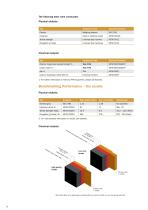 Website:
Trelleborg Marine and Infrastructure
Website:
Trelleborg Marine and Infrastructure
Group: Trelleborg
Catalog excerpts

Guaranteeing Fender Performance Why it’s not so black and white Trelleborg Marine Systems
Open the catalog to page 1
Fendering systems Fendering systems are mission critical equipment for marine environments globally. Long gone are the days of wooden or rope fenders, and the use of rubber has become standard best practice. Although rubber fenders have a long lifecycle, ultimately it is still limited. Depending on the environment and quality of the fender itself, the expected average lifespan will be approximately 15 to 20 years. Designing a fender system requires engineers to determine the berthing energy of a vessel or range of vessels that are likely to be docked against the system, then determining...
Open the catalog to page 2
Setting the Standards “Although PIANC is not in a position where it may “regulate the industry” or deliver any certification, PIANC is very careful to promote best practice. We also stress that in the long term, through life cycle approaches, it is recommended to use the most adapted, strong and resistant fender protection to quays.” Geoffrey Caude, PIANC President, 2011 There are a number of different standards used worldwide to design fender systems but the most commonly used is PIANC’s “Guidelines for the design of fender systems, 2002”, which was updated from its predecessor of 1984....
Open the catalog to page 3
The following tests were conducted: Physical analysis: Test Equipment Used Expected Standard Weighing balance Shore A hardness tester Tensile strength Universal test machine Universal test machinea Equipment Used Expected Standard Polymer (virgin plus recycled rubber) % Carbon black % Calcium Carbonate (white filler %) Chemical method Chemical analysis: 1. For further information on TGA and FTIR equipment, please see footnote. Benchmarking Performance – the results Physical analysis: Test High quality fender Elongation @ Break (%) 2. For more detailed information on results, see footnote....
Open the catalog to page 4
Interpretation of Test Results The cost of a fender is often reduced by using a higher percentage of recycled rubber, and low cost non-reinforcing white calcium carbonate (CaCO3) fillers in the formulation. We found that fenders with recycled rubber and filler are heavier (and denser) than virgin rubber fenders. This significant weight difference enables a user to evaluate whether a fender uses low cost recycled materials, or is the genuine article, made with high performance rubber compound, with the benefits of long life and superior resilience. Chemical and physical analyses revealed...
Open the catalog to page 5
Test now available These newly developed physical and chemical tests provide a reliable, viable analytical method which can now be made available for buyers to be able to assess the composition of recently procured fenders prior to delivery, using a simple sampling procedure from the surface of the fender. This new technique will help to ensure that fenders supplied use the correct quality of rubber compound required to adhere to the specification. The recommended tests to evaluate the quality of fenders, based on a sample of only 20-50grams are listed in the table below. These samples can...
Open the catalog to page 6
Footnotes 1. Analytical equipment like TGA/FTIR are not usually used in testing for the fender industry for quality control checks, but were applicable in this case to enable chemical analysis of the rubber compounds. TGA: Thermogravimetric Analysis measures the amount and rate of change in the weight of a material as a function of temperature or time in a controlled environment. Measurements are used primarily to determine the composition and predict thermal stability at temperatures up to 1000°C. The technique can characterize substances that exhibit weight loss or gain due to...
Open the catalog to page 7
Trelleborg Marine Systems designs, manufactures and installs bespoke fender systems, docking and mooring equipment, oil and gas transfer technology and vessel efficiency technology for marine environments all over the world. Our polymer engineering expertise also extends to our range of general marine products, including navigation aids and buoys. BLOG: http://marineinsightsblog.trelleborg.com TWITTER: @MarineInsights YOUTUBE: http://www.youtube.com/user/TrelleborgMarine LinkedIn Groups: MarineInsights
Open the catalog to page 8All Trelleborg Marine and Infrastructure catalogs and brochures
-
SafePilot brochure
20 Pages
-
Docking & Mooring
88 Pages
-
Pneumatic Fender infographic
1 Pages
-
Pneumatic Fenders brochure
28 Pages
-
Fender Application Design Manual
88 Pages
-
Multipurpose and Tug Fenders
44 Pages
-
Rolling Fenders and Safety
18 Pages
-
AutoMoor Brochure
24 Pages
-
Fender Systems
86 Pages
-
DynaMoor
20 Pages
-
Bollards
28 Pages
-
Solid SmartFender Factsheet
2 Pages
-
Ship-Shore Links Factsheet
4 Pages
-
SmartDAS Factsheet
2 Pages
-
TRELLEBORG DYNAMOOR
4 Pages
-
SmartDock ® Display Board
4 Pages
-
Surface Buoyancy
24 Pages
-
SmartMoor Series II
7 Pages
-
Performance Monitoring
3 Pages
-
Universal Safety Link
3 Pages
-
TRELLEBORG’S Tugger Winch
2 Pages
-
LNG Infographic
8 Pages
-
SafePilot User Guide
30 Pages
-
Safepilot SmartPort System
16 Pages
-
Combined ESDS & SSL
3 Pages
-
Ship Shore Link System
3 Pages
-
Emergency Shutdown Link
3 Pages
-
Floating Fenders
48 Pages
-
Prelude LNG
1 Pages
-
AutoMoor Datasheet
4 Pages
-
SafePilot CAT XT System
2 Pages
-
Whitepaper - Correction Factors
10 Pages
-
Mini Guide - Foam Fenders
5 Pages
-
Buoy Range Table
2 Pages
-
Hawser Hooks
6 Pages
-
Guide - Fenders
8 Pages
-
Barometer Report 3
16 Pages
-
Barometer Report 2
7 Pages
-
lload monitoring software
2 Pages
-
lload monitoring systeme
5 Pages
-
Remote Release System
6 Pages
-
Capstans
4 Pages
-
Accessories
10 Pages
Archived catalogs
-
Docking and mooring
2 Pages






















































































